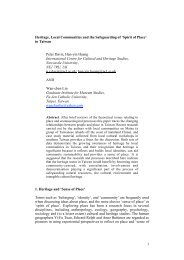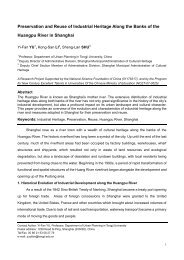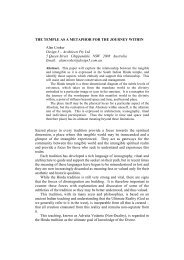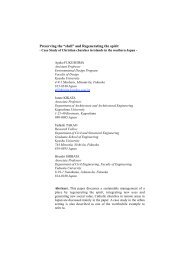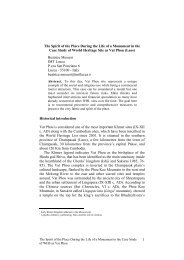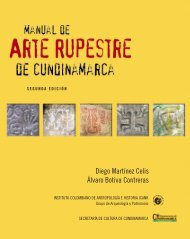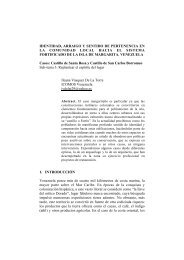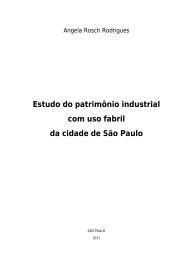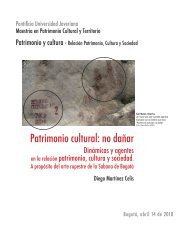<strong>Stone</strong> Decay 3ize terminology (<strong>Stone</strong> Federation <strong>of</strong> Great Britain 1991), governmentalorganizations (Grimmer 1984), and research groups (Fitzner, Heinrichs,and Kownatzki 1997).The ICOMOS-ISCS Illustrated Glossary on <strong>Stone</strong> DeteriorationPatterns (Vergès-Belmin 2008) helps define and clarify usage across languagesand within the stone community, providing useful definitions <strong>of</strong>terms such as scaling, spalling, and flaking. Weathering is generallydefined as the result <strong>of</strong> natural atmospheric phenomena, while decay is“any chemical or physical modification <strong>of</strong> the intrinsic stone propertiesleading to a loss <strong>of</strong> value or to the impairment <strong>of</strong> use,” degradation is“decline in condition, quality, or functional capacity,” and deteriorationis the “process <strong>of</strong> making or becoming worse or lower in quality, value,character, etc.” Some interesting details <strong>of</strong> the history <strong>of</strong> stone glossariescan be found in the introduction to the glossary.A more guided approach than a glossary can be found in work onexpert systems from the late 1990s, with Van Balen (1996; 1999) producingan atlas <strong>of</strong> damage to historic brick structures as part <strong>of</strong> an expertsystem for elucidating environmental effects on brick. The atlas evolvedinto a broader program known as the MDDS (Masonry DamageDiagnostic System) (Van Hees, Naldini, and Sanders 2006; Van Hees,Naldini, and Lubelli 2009). Expert systems have gone in and out <strong>of</strong> fashionover the past fifteen years, but the need to capture expert experienceand judgment has become ever more urgent, given the large number <strong>of</strong>conservation pr<strong>of</strong>essionals nearing retirement age.Fitzner has produced an important classification <strong>of</strong> weatheringforms as a basis for mapping the deterioration across a building facade(Fitzner, Heinrichs, and Kownatzki 1997). This system has also been presentedin case studies (Fitzner, Heinrichs, and La Bouchardiere 2004).Such complex systems have been criticized because <strong>of</strong> the number <strong>of</strong>parameters to be measured (Moraes Rodigues and Emery 2008) as wellas “cost concerns and the extensive training they require” (Dorn et al.2008). Fitzner’s classification recognizes nineteen different weatheringforms and goes some way toward recording the severity <strong>of</strong> each, basedon visual inspection (Fitzner 2004). Similar, but simpler systems havebeen described by Massa, Naldini, and Rorro (1991) and by Vergès-Belmin (1992). Zezza (1990; 1994; 2002) has used digital image processingto map different forms <strong>of</strong> surface decay. Starting with photographsand other nondestructive information, such as ultrasonic measurements,false color images are produced that identify particular forms <strong>of</strong> decay.HOW SERIOUS IS IT?MEASURING THE EXTENT AND SEVERITY OF DECAYIn order to make real progress, we need to quantify decay. In otherwords, in addition to describing the type <strong>of</strong> decay, it is essential that weare able to measure its extent, or the area it covers; its severity, or howadvanced the decay is; and the rate <strong>of</strong> decay over time. First, we need todo so in order to unravel its various causes. For example, how can we say
4 Chapter 1that pollution is causing decay unless we have some way <strong>of</strong> correlatingpollution levels with decay? Second, we need to have some objectivemeans <strong>of</strong> assessing the extent and the rate <strong>of</strong> decay in order to decidewhether remedial action is necessary and, if so, how urgent the need is.Third, we cannot establish whether our remedial actions are having anyeffect unless we can monitor the condition <strong>of</strong> the stone afterward.If one accepts these eminently reasonable preconditions, then weare left with a situation where extremely few monuments today (or evenpaintings) meet these basic conditions. <strong>Conservation</strong> decisions most <strong>of</strong>tenrest upon a framework <strong>of</strong> experience and general guidelines for treatmentcompatibility, instead <strong>of</strong> data on the actual behavior or rate <strong>of</strong> loss <strong>of</strong> themonument. <strong>Conservation</strong> documentation for the majority <strong>of</strong> our culturalheritage appears to consist <strong>of</strong> a few uncalibrated photographs takenunder different lighting conditions over a few decades. Helping to fill thisvoid with more quantitative and reproducible approaches has been theobjective <strong>of</strong> many <strong>of</strong> the research projects cited in this volume: turning“weathering” or “decay” into numbers.No single technique is sufficient to measure stone deterioration,since decay takes many different forms. Some techniques, such as 3Dlaser scanning and fluorescence LIDAR (light detection and ranging), lookonly at the surface, and they are well suited to decay that consists <strong>of</strong> agradual loss <strong>of</strong> surface, leaving sound stone behind. Other techniques,such as ultrasonic measurements, thermography, or magnetic resonanceimaging (MRI) are designed to probe below the surface, and these areuseful where decay consists <strong>of</strong> a loss <strong>of</strong> cohesion within the stone, or thedevelopment <strong>of</strong> detached layers, blisters, or internal voids.Before using more complex methods, simple visual examinationplays an important role in quantifying decay. A single examination canconvey the state <strong>of</strong> the stone at a particular moment, but it does not capturethe rate <strong>of</strong> decay. For this, a series <strong>of</strong> inspections is required, usuallyover a period <strong>of</strong> several years. Photographs are <strong>of</strong> immense value here,but their objectivity can be abused. Winkler (1975, p. 87), for example,constructs an alarming graph <strong>of</strong> exponentially increasing decay on thebasis <strong>of</strong> just two photographs. Even within a series <strong>of</strong> photographs, afundamental difficulty is that <strong>of</strong>ten they have been shot under differinglighting conditions, making the interpretation <strong>of</strong> surface loss challenging(GCI and IHAH 2006; Thornbush and Viles 2008).Two improvements in traditional photographic documentationshow promise. One is the use <strong>of</strong> time-lapse methods to provide morefrequent images in order to correlate surface loss with environmentalchanges (Sawdy and Heritage 2007; Doehne and Pinchin 2008; Zehnderand Schoch 2009). The other is a new method known as polynomialtransform mapping (PTM), a subset <strong>of</strong> RTI (Reflectance TransformImaging), that is, the use <strong>of</strong> multiple photographs from different angles todocument more comprehensively the texture <strong>of</strong> stone surfaces. This givesthe viewer the ability to control the angle <strong>of</strong> the light source in a givenimage using Java-based s<strong>of</strong>tware (Malzbender, Gelb, and Wolters 2001;Padfield, Saunders, and Malzbender 2005). See examples at: http://www
- Page 2 and 3: esearch in conservationThe Getty Co
- Page 4 and 5: Contentsvi Foreword to the Second E
- Page 6 and 7: ContentsvChapter 7 75 What Has Chan
- Page 8 and 9: Foreword to the Second Edition, 201
- Page 10: Preface to the Second Edition, 2010
- Page 13 and 14: Chapter Preface to # the First Edit
- Page 15 and 16: IntroductionAfter presenting his wo
- Page 20 and 21: Stone Decay 5.hpl.hp.com/news/2004/
- Page 22 and 23: Stone Decay 7ing the difficult chal
- Page 24 and 25: Stone Decay 9has shown that if both
- Page 26 and 27: Stone Decay 11Damage to stone by ai
- Page 28 and 29: Stone Decay 13Some intriguing findi
- Page 30 and 31: Stone Decay 15crossing the deliques
- Page 32 and 33: Stone Decay 17pick up moisture from
- Page 34 and 35: Stone Decay 19by differences in the
- Page 36 and 37: Stone Decay 21Biological growths on
- Page 38 and 39: Stone Decay 23have appeared determi
- Page 40 and 41: Stone Decay 25Organic material in p
- Page 42 and 43: Chapter 2Putting It Right: Preventi
- Page 44 and 45: Stone Putting Decay It Right: Preve
- Page 46 and 47: Stone Putting Decay It Right: Preve
- Page 48 and 49: Stone Putting Decay It Right: Preve
- Page 50 and 51: Stone Putting Decay It Right: Preve
- Page 52 and 53: Stone Putting Decay It Right: Preve
- Page 54 and 55: Stone Putting Decay It Right: Preve
- Page 56 and 57: Stone Putting Decay It Right: Preve
- Page 58 and 59: Stone Putting Decay It Right: Preve
- Page 60 and 61: Stone Putting Decay It Right: Preve
- Page 62 and 63: Stone Putting Decay It Right: Preve
- Page 64 and 65: Chapter 3Do They Work? Assessing th
- Page 66 and 67: Stone Do They Decay Work? Assessing
- Page 68 and 69:
Stone Do They Decay Work? Assessing
- Page 70 and 71:
Stone Putting Decay It into Practic
- Page 72 and 73:
Stone Putting Decay It into Practic
- Page 74 and 75:
Stone Heritage Decay in Stone: Rock
- Page 76 and 77:
Stone Heritage Decay in Stone: Rock
- Page 78 and 79:
Stone Heritage Decay in Stone: Rock
- Page 80 and 81:
Stone Heritage Decay in Stone: Rock
- Page 82 and 83:
Stone Doing Decay Better: Increasin
- Page 84 and 85:
Stone Doing Decay Better: Increasin
- Page 86 and 87:
Stone Doing Decay Better: Increasin
- Page 88 and 89:
Stone Doing Decay Better: Increasin
- Page 90 and 91:
Chapter # 7Chapter What Has Title C
- Page 92 and 93:
Stone What Has Decay Changed? Some
- Page 94 and 95:
Stone What Has Decay Changed? Some
- Page 96 and 97:
Chapter References #Chapter TitleAu
- Page 98 and 99:
References 83ed. D. Decrouez, J. Ch
- Page 100 and 101:
References 85Balboni, E., R. M. Esp
- Page 102 and 103:
References 87Bläuer, C., and A. Ku
- Page 104 and 105:
References 89carried out on Lecce s
- Page 106 and 107:
References 91Charola, A. E. 1995. W
- Page 108 and 109:
References 93Davis, K. J., and A. L
- Page 110 and 111:
References 95Doehne, E., and S. Pin
- Page 112 and 113:
References 97Facaoaru, I., and C. L
- Page 114 and 115:
References 99Buildings and Monument
- Page 116 and 117:
References 101Historia. http://www.
- Page 118 and 119:
References 103Poland, ed. J. W. Luk
- Page 120 and 121:
References 105the International RIL
- Page 122 and 123:
References 107Jurado, V., A. Fernan
- Page 124 and 125:
References 109Kumar, N., U. C. Kuls
- Page 126 and 127:
References 111“Conservation of St
- Page 128 and 129:
References 113Maravelaki-Kalaitzaki
- Page 130 and 131:
References 115Meinhardt-Degen, J.,
- Page 132 and 133:
References 117Mosch, S., and S. Sie
- Page 134 and 135:
References 119Paradise, T. R. 2002.
- Page 136 and 137:
References 121of porous stones: A u
- Page 138 and 139:
References 123Rodríguez-Navarro, C
- Page 140 and 141:
References 125Sawdy, A., A. Heritag
- Page 142 and 143:
References 127Siedel, H. 2008. Salt
- Page 144 and 145:
References 129Snethlage, R. 2005. L
- Page 146 and 147:
References 131the responsible and e
- Page 148 and 149:
References 133Vallet, J.-M., C. Gos
- Page 150 and 151:
References 135Viles, H. A., D. Camu
- Page 152 and 153:
References 137Whitley, D. S. 2005.
- Page 154 and 155:
References 139Zezza, F. 1990. Compu
- Page 156 and 157:
Appendix: Resources for Stone Conse
- Page 158 and 159:
Appendix: Resources for Stone Conse
- Page 160 and 161:
Appendix: Resources for Stone Conse
- Page 162 and 163:
Appendix: Resources for Stone Conse
- Page 164 and 165:
Appendix: Resources for Stone Conse
- Page 166 and 167:
Appendix: Resources for Stone Conse
- Page 168 and 169:
Index 153calcium hydroxide (slaked
- Page 170 and 171:
Index 155hexafluoropropene-vinylide
- Page 172 and 173:
Index 157research needed on, 55-56w
- Page 174 and 175:
About the AuthorsEric Doehne holds



